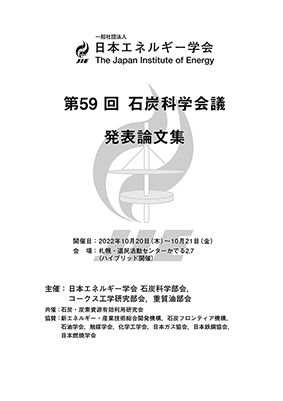第59回石炭科学会議
選択された号の論文の48件中1~48を表示しています
- |<
- <
- 1
- >
- >|
開催案内・プログラム
-
p. 0_1-0_3
発行日: 2022/10/13
公開日: 2022/11/01
PDF形式でダウンロード (180K) -
p. 0_4-0_6
発行日: 2022/10/13
公開日: 2022/11/01
PDF形式でダウンロード (202K)
招待講演・特別講演
-
p. ii-xi
発行日: 2022/10/13
公開日: 2022/11/01
PDF形式でダウンロード (4216K) -
p. xii-xxi
発行日: 2022/10/13
公開日: 2022/11/01
PDF形式でダウンロード (1582K) -
p. xxii-xxix
発行日: 2022/10/13
公開日: 2022/11/01
PDF形式でダウンロード (5519K) -
p. xxx-xxxv
発行日: 2022/10/13
公開日: 2022/11/01
PDF形式でダウンロード (2040K)
研究発表
ガス化・燃焼、熱分解・コークス
-
p. 2-3
発行日: 2022/10/13
公開日: 2022/11/01
PDF形式でダウンロード (657K) -
p. 4-5
発行日: 2022/10/13
公開日: 2022/11/01
PDF形式でダウンロード (921K) -
p. 6-7
発行日: 2022/10/13
公開日: 2022/11/01
PDF形式でダウンロード (736K) -
p. 8-9
発行日: 2022/10/13
公開日: 2022/11/01
PDF形式でダウンロード (573K)
熱分解・コークス、 カーボンリサイクル
-
p. 10-11
発行日: 2022/10/13
公開日: 2022/11/01
PDF形式でダウンロード (1714K) -
p. 12-13
発行日: 2022/10/13
公開日: 2022/11/01
PDF形式でダウンロード (618K) -
p. 14-15
発行日: 2022/10/13
公開日: 2022/11/01
PDF形式でダウンロード (545K) -
p. 16-17
発行日: 2022/10/13
公開日: 2022/11/01
PDF形式でダウンロード (608K)
改質・処理・クリーン化、その他
-
p. 18-19
発行日: 2022/10/13
公開日: 2022/11/01
PDF形式でダウンロード (751K) -
p. 20-21
発行日: 2022/10/13
公開日: 2022/11/01
PDF形式でダウンロード (683K) -
p. 22-23
発行日: 2022/10/13
公開日: 2022/11/01
PDF形式でダウンロード (741K)
構造・物性、灰・微量元素
-
p. 24-25
発行日: 2022/10/13
公開日: 2022/11/01
PDF形式でダウンロード (1774K) -
p. 26-27
発行日: 2022/10/13
公開日: 2022/11/01
PDF形式でダウンロード (596K) -
p. 28-29
発行日: 2022/10/13
公開日: 2022/11/01
PDF形式でダウンロード (704K)
ガス化・燃焼
-
p. 30-31
発行日: 2022/10/13
公開日: 2022/11/01
PDF形式でダウンロード (624K) -
p. 32-33
発行日: 2022/10/13
公開日: 2022/11/01
PDF形式でダウンロード (820K) -
p. 34-35
発行日: 2022/10/13
公開日: 2022/11/01
PDF形式でダウンロード (904K) -
p. 36-37
発行日: 2022/10/13
公開日: 2022/11/01
PDF形式でダウンロード (762K)
ガス化・燃焼、改質・処理・クリーン化
-
p. 38-39
発行日: 2022/10/13
公開日: 2022/11/01
PDF形式でダウンロード (645K) -
p. 40-41
発行日: 2022/10/13
公開日: 2022/11/01
PDF形式でダウンロード (5783K) -
p. 42-43
発行日: 2022/10/13
公開日: 2022/11/01
PDF形式でダウンロード (1092K) -
p. 44-45
発行日: 2022/10/13
公開日: 2022/11/01
PDF形式でダウンロード (609K)
灰・微量元素1
-
p. 46-47
発行日: 2022/10/13
公開日: 2022/11/01
PDF形式でダウンロード (753K) -
p. 48-49
発行日: 2022/10/13
公開日: 2022/11/01
PDF形式でダウンロード (1232K) -
p. 50-51
発行日: 2022/10/13
公開日: 2022/11/01
PDF形式でダウンロード (790K)
灰・微量元素2
-
p. 52-53
発行日: 2022/10/13
公開日: 2022/11/01
PDF形式でダウンロード (585K) -
p. 54-55
発行日: 2022/10/13
公開日: 2022/11/01
PDF形式でダウンロード (969K) -
p. 56-57
発行日: 2022/10/13
公開日: 2022/11/01
PDF形式でダウンロード (957K)
熱分解・コークス、重質油
-
p. 58-59
発行日: 2022/10/13
公開日: 2022/11/01
PDF形式でダウンロード (1121K) -
p. 60-61
発行日: 2022/10/13
公開日: 2022/11/01
PDF形式でダウンロード (892K) -
p. 62-63
発行日: 2022/10/13
公開日: 2022/11/01
PDF形式でダウンロード (1049K) -
p. 64-65
発行日: 2022/10/13
公開日: 2022/11/01
PDF形式でダウンロード (586K)
構造・物性、カーボンリサイクル、その他
-
p. 66-67
発行日: 2022/10/13
公開日: 2022/11/01
PDF形式でダウンロード (666K) -
p. 68-69
発行日: 2022/10/13
公開日: 2022/11/01
PDF形式でダウンロード (710K) -
p. 70-71
発行日: 2022/10/13
公開日: 2022/11/01
PDF形式でダウンロード (681K) -
p. 72-73
発行日: 2022/10/13
公開日: 2022/11/01
PDF形式でダウンロード (834K)
バイオマス1
-
p. 74-75
発行日: 2022/10/13
公開日: 2022/11/01
PDF形式でダウンロード (960K) -
p. 76-77
発行日: 2022/10/13
公開日: 2022/11/01
PDF形式でダウンロード (477K) -
p. 78-79
発行日: 2022/10/13
公開日: 2022/11/01
PDF形式でダウンロード (519K)
バイオマス2
-
p. 80-81
発行日: 2022/10/13
公開日: 2022/11/01
PDF形式でダウンロード (399K) -
p. 82-83
発行日: 2022/10/13
公開日: 2022/11/01
PDF形式でダウンロード (825K) -
p. 84-85
発行日: 2022/10/13
公開日: 2022/11/01
PDF形式でダウンロード (476K)
- |<
- <
- 1
- >
- >|
